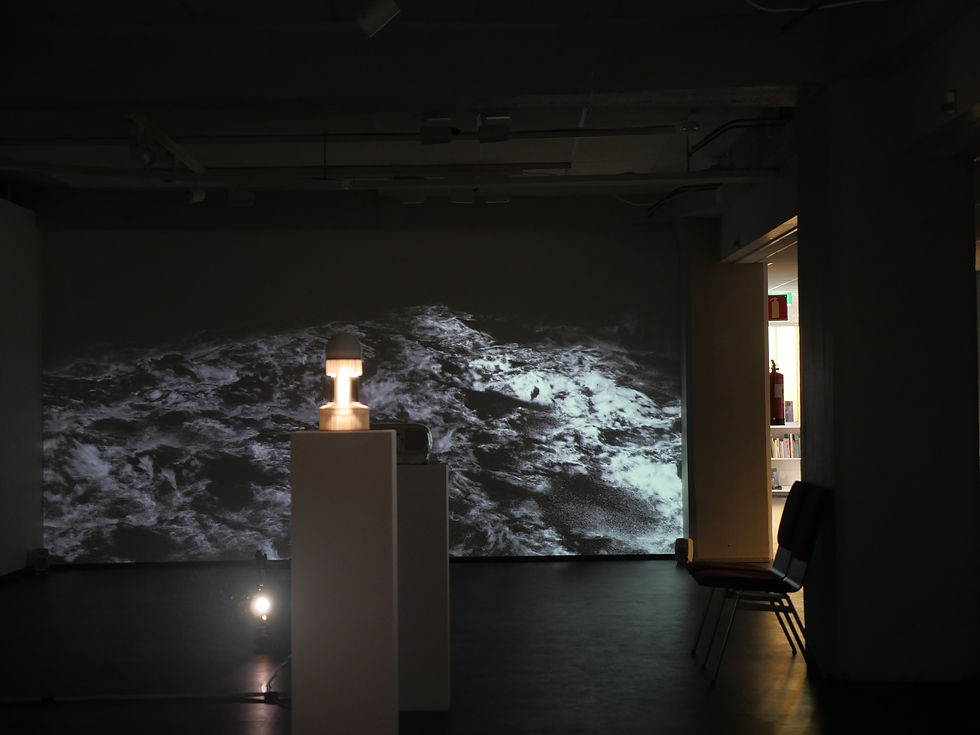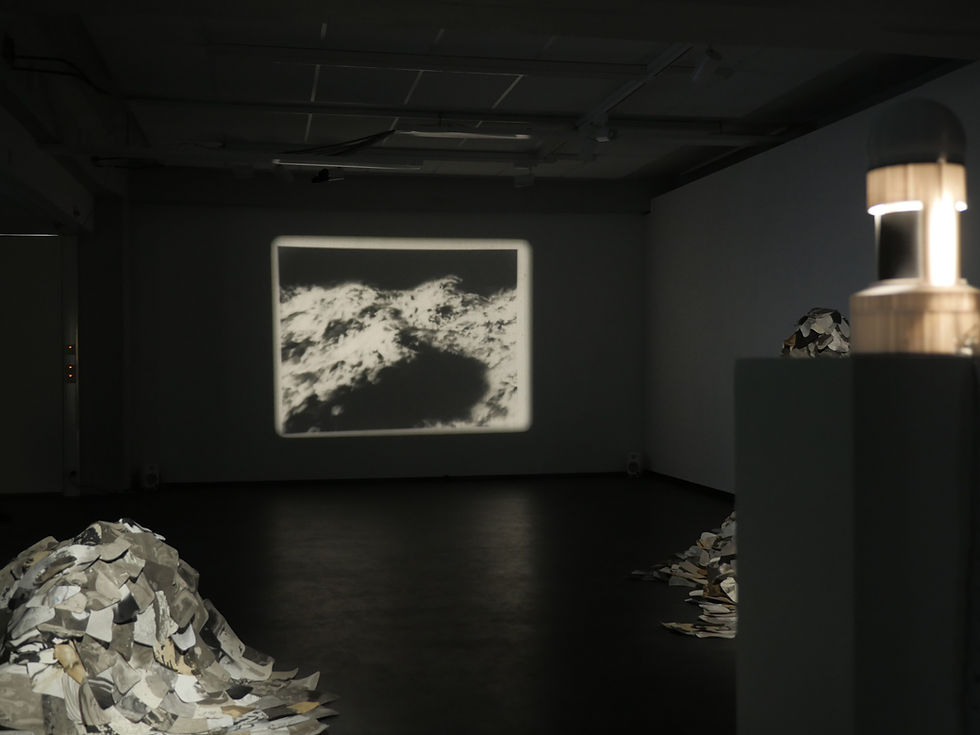The wave in the mind
with Emma Fält
2024
LED light, motor, 3d-printed PLA lamp case, laser engraved papers, data-driven simulation, 16-mm projection, Suminagashi prints on recycled paper, 4-channel sound
Before the advent of powerful computer and sensing technology, wave phenomena were only described and logged by visual observation and subjective evaluation of individuals. “The Beaufort scale, which is used in Met Office marine forecasts, is an empirical measure for describing wind intensity based on observed sea conditions.” Since the 19th century, the scale has become a standard for ship's log entries.
The two videos are the result of a simulation of two storms:
Rafael on 22-Dec-2004 at 22:20 that happened in the Baltic Sea. The data relative to this sea condition, gently provided by the Finnish Meteorological Institute (FMI), were measured at the buoy in the Northern Baltic: 59°15´ N, 21°00´ E., close to the Suomen Leijona lighthouse. They feed a physically based mathematical model of wave motion and a computer program developed by Roberto to generate the 3d visualization.
The second storm was experienced by a Swedish vessel, Pommern on the 5th of March 00:00–4:00, 1934. For this event, only the human interpretation of the phenomena can be read on the ship logs, which are available from the digital archive of the Åland Maritime Museum.
Currently, an increased amount of data, in terms of time accuracy and spatial diffusion, more accurate mathematical models, and machines with increased computation power, allow scientists to more realistically describe and visualize phenomena and provide more accurate forecasts of meteorological events.
Simulation technology allows one to model and predict phenomena but also reconstructs events that we haven’t witnessed in the first place, first person. Here, thanks to the available historical data, the simulation is a time machine that creates narratives and writes stories of the past. It is a speculative recording, a sequence of images no camera has captured, only a buoy and its embedded sensors.
Computation shapes both the future of our experiences and our understanding of the past. The scale-model lighthouse in the middle of the room rhythmically investigates the space and presents us with glimpses of three touching horizons.
On the other hand, tactile sense and listening to matter through the human body can offer us different kinds of knowledge about the environment. The two big but fragile paper bodies are covered with hundreds of encounters, attempts to connect with water to understand how its movements move the being experiencing them. By using the old traditional printing technique, Suminagashi or "floating ink" on water, the prints appear different depending on the surface tension. Understanding the surface tension of water is important in a wide range of applications including heat transfer, desalination, and oceanography. Much we can observe just by looking at the surface, yet we know little about the life underneath the surfaces of different bodies, being it humans or bodies of water.
The soundscape is created by following the simulation of storm waves and recording the sounds of drawing. Emma has been using different materials, pen on paper, paper on wood, metal on wood as well hands moving on different surfaces. Voice artist Anna Fält was connecting with the winds, the simulation as well as the little details of the waves using her voice. They wanted to use their bodies as instruments of “becoming another body” to attune with a body that is not human or even considered alive.
In the installation, the long gone, emerging, and invisible bodies connect, hide and cover as well as shelter. All the different patterns and waters are mixed and moving endlessly. Little do we understand all the connections between elements and natural forces. Right now, it seems more than important to think about our knowledge formation and boldly weave together different ways of exploring and understanding the world.




DATA as seeds of storytelling
For Rafael, on 22nd December 2004, the significant wave height in northern Baltic Proper reached 8.2 meters and the highest individual wave height was 14 meters. Toini, January 12th 2017 a similar significant wave height (8.0 m) was recorded. Sensing technology embedded in buoys provides detailed data at one point and time that allows researchers to simulate the overall aspect of the waves. The time series, that is the collected data in time, provides us with a timeline of what happened. This story is told in a language very few speak, which is difficult to understand but also very simple. Every sensing technology reduces a phenomenon under scrutiny to a few observable physical quantities. It is a reduction that leaves many things untold.
The animation presented in the digital projection and the laser engravings on paper are attempts to use the data through a physically-based inspired simulation, a mathematical model, a set of formulas, to give life to these stories.
Characterizing a complex phenomenon such as the sea state is prone to fail. It is in this impossibility that we can rediscover the meaning of experience over simulation, the articulation of material forces that cannot be reduced to equations and parameters.
When sensing technology was unavailable, a duration that encompasses most of the history of humankind, sailors used their observational skills to talk about the sea. Subjectivity was embedded in the handwritten logs of ships. For Pommern ‘34, only a speculative reconstruction of the storm was possible: to read and imagine, to fantasize about an experience and translate it into parameters of a computational model. These ship logs are data as well, they are snapshots of observations and felt experiences. The 16-mm film projection, realized in collaboration with live cinema artist Marek Pluciennik, translates an old story into an old medium, film, to remind us that the history of stories is also a history of the technology used to write and share them.
1 - Lighthouse, LED light, motor, 3D-printed PLA lamp case
2 - Bodies - paper sculpture, Suminagashi prints on recycled paper
3 - Rafael 2004 - data-driven simulation, digital projection
4 - Pommern 1934 - ship journal-informed speculative reconstruction of the storm on 16-mm projection
5 - Toini 2007, data-driven simulation, Laser-engraved print
6 - 4-channel sound from drawing on paper, wood and metal